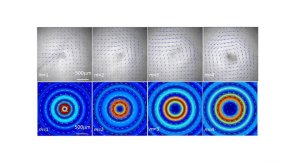Engineers have created tiny acoustic vortices and used them to grip and spin microscopic particles suspended in water.
SOURCE: Latest Science News — ScienceDaily – Read entire story here.
Related posts:
- Pembrolizumab shows real promise against head and neck cancer, study suggests Immunotherapy with the anti-PD-1 antibody pembrolizumab decreased the size of tumors by 30 percent or more in 24.8 percent of 132 patients with recurrent or metastatic head and neck cancer. That's nearly twice as effective as the current preferred treatment. ...
- Restricting firearms access for people who misuse alcohol may prevent violence Restricting access to firearms for people who misuse alcohol could prevent firearm violence, but policies that more clearly define alcohol misuse should be developed to facilitate enforcement, according to a review of existing research and public policies. ...
- Colorectal cancer genetically different in older and younger patients While the overall rate of colorectal cancer (CRC) is declining, CRC specifically among young patients is increasing. Previous studies have shown that CRC in patients younger than 50 years old tends to be more aggressive than CRC in older patients. A new study offers early evidence of genetic differences between CRC in young and old patients, possibly pointing toward different treatments and strategies in combating the young form of the disease. ...
- Carbon nanotubes grown in combustion flames An international research team’s theoretical simulation of the synthesis of single-walled carbon nanotubes has revealed important details of the mechanisms at play. This could lead to better ways to control the production of carbon nanotubes. ...
- Stem cell switch on the move The roots of a plant are constantly growing, so that they can provide the plant with water and minerals while also giving it a firm anchor in the ground. Responsible for these functions are pluripotent stem cells. In order to avoid differentiation and to remain pluripotent, these stem cells are dependent on signals from their neighboring cells. These signals are generated by only a small group of slowly dividing cells in the so-called quiescent centre inside the root. Biologists can now demonstrate how signals in plant roots determine the activity of stem cells. ...




